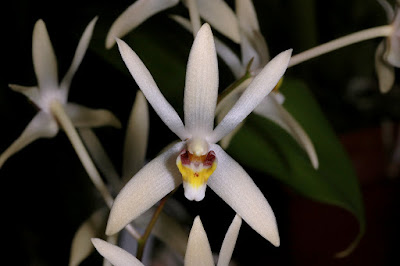Epigeneium cymbidioides are distributed from the Himalaya to Southern China, Indonesia, the Philippines to New Guinea. It grows in moss forests at elevations of 2200 to 2800 meters above sea level.
Epigeneium cymbidioides also called as The Cymbidium-Like Epigeneium, Callista cymbidiodes, Callista marginata, Dendrobium banghamii, Dendrobium cymbidioides, Dendrobium marginatum, Dendrobium triflorum, Desmotrichum cymbidioides, Katherinea cymbidioides, Sarcopodium cymbidioides, is a species of the genus Epigeneium. This species was described by Victor Samuel Summerhayes in 1957.
IDENTIFY EPIGENEIUM CYMBIDIOIDES ORCHID PLANT
Epigeneium cymbidioides are distributed from the Himalaya to Southern China, Indonesia, the Philippines to New Guinea. It grows in moss forests at elevations of 2200 to 2800 meters above sea level.
It is a small sized, cold growing epiphyte with well spaced, ovoid, fleshy pseudobulbs carrying 2 oblong, fleshy, bilobed and obtuse apically leaves.
The Cymbidium-Like Epigeneium blooms in the spring on an apical, short to 20 cm, erect to arcuate, several flowered inflorescence that has small, hyaline, triangular, basal bracts with up to 12, long-lasting, heavy textured flowers that are poorly scented. The flowers are fair sized with spreading oblong sepals and petals, pale greenish yellow in colour. The lip is short and heart-shaped and is white in colour, blotched with purple at the base, the disk having 2 or 3 lines of small lumps or tubercles. The sides lobes are incurved.
EPIGENEIUM CYMBIDIOIDES ORCHID PLANT CARE AND CULTURE
Cultural information should only be used as a guide, and should be to be adapted to suit you. Your physical location; where you grow your plants, how much time you have to devote to their care, and many other factors, will need to be taken into account. Only then can you decide on the cultural methods that best suit you and your plants.
Light:
Epigeneium cymbidioides do best in full sunshine (25000-50000 lux), close to the glass where glasshouse treatment is required. In addition to the natural light, you will have to use artificial light lamps.
Temperature:
The average temperature of the summer day is 25-26 ° C, night 21 ° C, giving a daily difference of 4-6 ° C. In winter, the average day temperature is 27-30 ° C, night 16-17 ° C, giving a daily difference of 13 ° C.
Humidity:
The Cymbidium-Like Epigeneium need the humidity of 80-90% throughout the growing period (i.e. from the time the first shoots of Spring show themselves until the last pseudobulb in Summer has grown to its maximum). In winter, the humidity drops to 65%.
Too dry air has a negative effect on the development of the plant: its growth is inhibited, and the leaves begin to turn yellow and dry out. The higher temperature, the higher the humidity should be, and the higher the humidity, the more often and longer it is necessary to ventilate the room where the plants are contained, otherwise the probability of rotting and various kinds of fungal diseases.
Substrate, growing media and repotting:
Epigeneium cymbidioides grows best in pots with osmunda fibre as substrate (crocks and charcoal at the bottom of the pot). After potting, keep the plant in a cool, shady place for a few days before placing it in its growing position. Do not overpot. Use the smallest pot that will accommodate your plant.
It does not need frequent repot, therefore, it is desirable to transplant only when it is really necessary, for example, in cases of strong salinization or compaction of the substrate, at its critically high or low pH (the norm is from 5.5 to 6.5) or when the plant grows very strongly and the pot becomes cramped to it (pseudobulbs begin to hang from the edges of the pot). Repotting is best done immediately after flowering when new roots and new growth begin to grow.
Watering:
Water must be literally poured on throughout the summer season right up to the time when the season's growths have reached full development; with the coming of autumn the quantity of water should be appreciably diminished, but this plant should not be allowed to dry out, and even in midwinter watering should be continued by giving the compost a good soaking once a fortnight-choosing a bright, clear morning for the purpose.
Watering is directly dependent on the temperature of the content, the higher it is, the more often it needs to be watered. When watering, excess water should flow freely from the pot, since stagnation of water both inside the pot and in its pan can very quickly lead to rotting of the roots and the lower part of the plant.
Fertilizer:
It is recommended to use a 1/4-1/2 dose of orchid fertilizer weekly. You can use the balanced fertilizer throughout the year or from spring to mid-summer use high-nitrogen fertilizer, and then until the end of autumn high-phosphoric fertilizer to stimulate flowering.
Rest period:
Epigeneium cymbidioides need less water in the winter, especially if they grow under the conditions of a dark, short day that occurs at moderate latitudes. They should dry somewhat between waterings, but they should not be dry for a longer period. Frequent morning fogging and rare, economical watering should allow the plant to go through a dry period of rest, while providing it with sufficient humidity. Fertilization should be reduced or eliminated until new growths appear and a more abundant spring watering begins.















COMMENTS